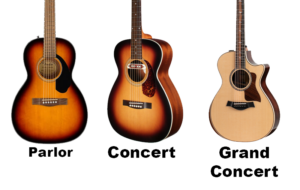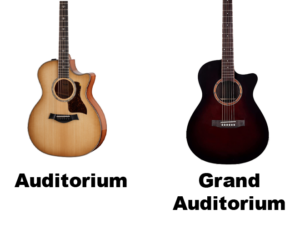Uncategorized
How to Play THE BEATLES’ “Come Together” on the 3-String Guitar
Tune up, plug in, and rock out to one of the Beatles’ most classic and riff-laden masterpieces. This arrangement is specifically for the 3-string guitar and was arranged to be played using a finger slide. It can, however, be played note-by-note whether you use a slide, or fret the notes without a slide.
The Tablature below corresponds to the video performance above.
The tuning for this song is Open G Tuning (G-D-G). To achieve this tuning, string your 3-string guitar up with the A, D, & G string from a standard 6-string guitar pack, and tune the strings to the notes G-D-G.
The key to playing this song correctly, is to think of it as two separate guitar parts that are being played simultaneously. The right-hand thumb is playing a bassline on each downbeat, and the rest of the fingers on the right hand pick the melody notes. It’s important to isolate the two parts and practice them separately in order to master this technique. This style of playing a melody and bassline simultaneously is popular in the “Mississippi Hill Country Blues” style of picking. To check out a complete lesson on this style CLICK HERE.
Thanks for keeping the Roots alive, and don’t forget to click “FOLLOW” on the right-hand side of this page to stay up-to-date with new lessons and articles!
The 3-String Guitar used in this video lesson was crafted by:
Bill Turner of Wunkywerks Guitars
Etsy Store: https://www.etsy.com/shop/WunkywerksGuitars
Email: Wunkywerksguitars@gmail.com

Uncategorized
Acoustic Guitar Sizes: Finding Your Perfect Fit
Have you ever wondered how the size of an acoustic guitar affects its sound? From the intimate, focused tones of a parlor guitar to the deep, resonant sound of a jumbo, the size and shape of an acoustic guitar can have a profound impact on its sonic characteristics.”
In this article, we’ll explore acoustic guitar sizes, their variations, and how to choose the perfect size that suits your needs.
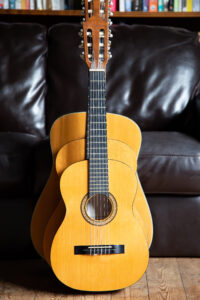 Understanding Acoustic Guitar Sizes: A Musical Puzzle
Understanding Acoustic Guitar Sizes: A Musical Puzzle
Acoustic guitar sizes refer to the dimensions and proportions of the guitar body, which significantly influence the instrument’s tonal characteristics, projection, and playability.
Just like pieces of a musical puzzle, different sizes create distinct voices that cater to various playing styles and preferences.
The Spectrum of Acoustic Guitar Sizes
Acoustic guitars come in several sizes, each with its unique qualities and attributes. Let’s explore some common acoustic guitar sizes and their defining features:
-
-
Parlor Guitar: The parlor guitar is petite and charming, making it an ideal companion for intimate settings.
The name comes from the rooms in which the guitar was typically played in the late 19th century.
Some famous musicians who have been known to use the parlor guitar are, Eric Clapton, Mark Orton, Ed Sheehan, and John Mayer
Its smaller size results in a focused and balanced sound, perfect for fingerpicking and folk music.
-
Concert Guitar: Slightly larger than the parlor guitar, the concert guitar offers enhanced projection and volume. It strikes a balance between portability and sound, making it versatile for various genres.
It is often used in classical music and flamenco music with its full sound.
-
Grand Concert Guitar: With a larger body than the concert guitar, the grand concert guitar boasts a fuller sound and improved tonal complexity.
A popular choice for those who have a smaller stature and require an instrument that’s built to a shorter scale. Great choice for traveling musicians who often play live performances.
It’s suitable for fingerstyle playing and intricate arrangements.
-
Auditorium Guitar: The auditorium guitar, also known as the orchestra model (OM), features a well-rounded sound with a pronounced midrange.
More shallower than the dreadnought and narrower in width than a concert guitar. An Auditorium guitar brings the body closer to the player, making it feel more intimate and comfortable for stage use.
Some famous musicians who play it include Ed Sheeran, John Mayer, and Eric Clapton.
-
Grand Auditorium Guitar: Expanding on the auditorium guitar’s design, the grand auditorium guitar offers a versatile sound profile with enhanced bass response and overall volume.
It is a versatile mid-sized guitar that is a good choice for those who want a single guitar to travel with. The tone is great for strumming and picking. It performs well on stage and in the studio.
It suits a wide range of musical genres.
-
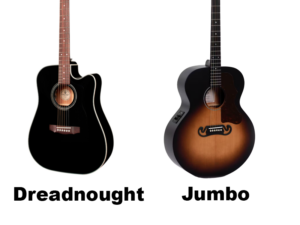 Dreadnought Guitar: The Dreadnought is a true icon, known for its bold and powerful sound. Its large body produces a strong bass response, making it ideal for strumming and vocal accompaniment.
Dreadnought Guitar: The Dreadnought is a true icon, known for its bold and powerful sound. Its large body produces a strong bass response, making it ideal for strumming and vocal accompaniment.This guitar is known for its powerful voice and lower-mid-rich tones that make it a favored choice for country artists. Although it is a popular choice for musicians of all genres.
Some famous musicians who play the dreadnought guitar include Hank Williams Jr, Elvis Presley, Keith Richards, Thom Yorke, and Kurt Cobain.
The original dreadnought guitars were made for the Oliver Ditson Company and featured mahogany backs and sides and spruce tops.
-
Jumbo Guitar: The jumbo guitar lives up to its name with a massive body that delivers robust volume and a deep bass presence.
This is the largest of the guitar family with a deeper body than the popular dreadnought. The body is wider and deeper than traditional acoustic guitars, which gives them a unique appearance.
Jumbo’s are well suited to rhythm guitarists in country and folk rock, and produce a deep rich sound favored by heavy strummers. Some famous musicians who play this guitar are Elvis Presley, George Harrison of the Beatles, Neil Young, Sheryl Crow, and Pete Townshend of The Who.
Choosing the Right Acoustic Guitar Size for You
Selecting the right acoustic guitar size involves considering factors such as playing style, comfort, and tonal preferences. Here are some steps to guide you on your quest:
-
Identify Your Playing Style: Determine whether you lean towards fingerpicking, strumming, or a mix of both. Different sizes excel in different playing styles, so choose one that complements your technique.
-
Consider Body Comfort: Hold and play guitars of various sizes to assess comfort. A guitar that fits well against your body ensures a pleasant playing experience, especially during extended sessions.
-
Evaluate Sound Preferences: Listen to the sound produced by different acoustic guitar sizes. Pay attention to tonal qualities, such as warmth, brightness, and projection, to find the one that resonates with your musical taste.
The Influence of Acoustic Guitar Sizes on Music
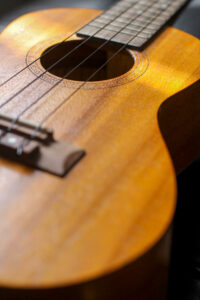 Acoustic guitar sizes and shapes can have a significant impact on the sound of the instrument.
Acoustic guitar sizes and shapes can have a significant impact on the sound of the instrument.The size of the guitar body type also relates to the volume of air within the instrument. Changes to the air capacity of the body will emphasize specific frequencies. A smaller body will have a more focused sound centered on higher frequencies, while a larger body will produce deeper low-end frequencies.
Body dimensions can provide some indication of the tone you might expect, but other factors exert a profound influence, too. Much depends on the tonewoods used to construct the body and the shape, size, and layout of the braces.
Finding Harmony in Acoustic Guitar Sizes
By delving into the nuances of size, sound, and playability, you’ve gained insights that will guide you toward the perfect fit for your musical aspirations.
As you continue your exploration, remember that each acoustic guitar size has its own unique voice and character. Embrace the joy of trying different sizes, celebrate the nuances of their sounds, and let your heart lead you to the one that resonates with your musical soul.
-
Uncategorized
Unlocking the A# Guitar Chord: A Harmonious Expedition
Greetings, fellow music enthusiasts and aspiring guitarists! Are you ready to embark on a melodious journey and explore the captivating world of the A# guitar chord? In this guide, we will unravel the mysteries of this unique chord, learn how to play it on your guitar, and understand its potential to add depth and emotion to your musical creations. Whether you’re a beginner eager to expand your chord repertoire or a curious soul seeking to enhance your musical knowledge, this article is your gateway to mastering the mesmerizing “A# guitar chord.” So, grab your guitar, find a comfortable spot, and let’s dive into the harmonious realm of musical expression and creativity!
Unveiling the A# Chord: A Sonic Adventure
Imagine the A# guitar chord as a musical key that opens the door to a world of melodic possibilities. Also known as A sharp, this chord carries a unique tonal quality that can add flair and intrigue to your playing. Let’s embark on a journey to discover the mechanics of playing the A# chord on your guitar and uncover its hidden charm.
Mastering the A# Chord: Crafting Musical Brilliance
To play the A# chord, follow these simple steps:
1. Finger Placement: Begin by placing your index finger on the 1st fret of the A string (the fifth thickest string), marking the root note A#.
2. Middle Finger: Position your middle finger on the 1st fret of the D string (the fourth thickest string), forming the minor third (C#).
3. Ring Finger: Place your ring finger on the 1st fret of the G string (the third thinnest string), creating the perfect fifth (F#).
4. Pinky Finger: Finally, use your pinky finger to press down on the 1st fret of the B string (the second thinnest string), adding the minor seventh (G#).
5. Strumming: Focus on strumming the A, D, G, and B strings (the thickest through second thinnest strings) while avoiding the low E string (the sixth string) and high E string (the first string).
6. Sound Check: Strum the strings individually to ensure each note rings out clearly. Adjust finger placement if needed for optimal resonance.
Exploring A# Chord Variations: Elevating Your Musicality
While the A# chord is inherently captivating, you can add variations to your playing to create different moods and textures. Here are a couple of ways to experiment:
1. Barre Chord Variation: Challenge yourself with a barre chord version of A# by using your index finger to bar all strings on the 1st fret, and then adding your other fingers as described above.
2. Fingerpicking Patterns: Dive into fingerpicking techniques to create intricate patterns that emphasize the individual notes of the A# chord.
A# Chord in Action: Musical Styles
The A# chord’s distinct tonality makes it a favorite choice across various musical genres. Here are a few popular songs that feature the A# chord:
1. “Thinking Out Loud” by Ed Sheeran: The A# chord contributes to the romantic atmosphere of this heartfelt ballad, enhancing the song’s emotional impact.
2. “Blackbird” by The Beatles: This iconic track showcases the A# chord, creating a sense of nostalgia and timeless beauty.
Tips for Mastering the A# Chord
As you embark on your journey to master the A# chord, consider these tips to refine your playing:
1. Practice Regularly: Dedicate consistent practice sessions to build muscle memory and familiarity with the A# chord shape.
2. Smooth Chord Transitions: Work on transitioning between the A# chord and other chords to enhance your overall playing fluency.
3. Experiment with Strumming Patterns: Vary your strumming patterns to explore different rhythmic possibilities and add dynamic expression to your sound.
Conclusion: Embrace the Elegance of the A# Chord
Congratulations, you’ve ventured into the harmonious world of the A# guitar chord! As you strum, experiment with variations, and explore songs, you’ll discover the power of this chord to add depth, emotion, and flair to your musical creations. Keep practicing, keep experimenting, and keep embracing the enchanting allure of the A# chord. It’s your key to unlocking a world of musical expression, where each note resonates with elegance and allure. So, pick up your guitar, let your fingers dance across the strings, and let the captivating A# chord guide you toward a realm of melodies that captivate the senses and elevate the spirit, one harmonious note at a time!
Uncategorized
Strumming Up Fun and Learning: Guitar Lessons for Kids
In the world of music, the guitar is a magical instrument that invites people of all ages to create beautiful melodies and express themselves through sound. For kids, the guitar holds a special allure, offering a gateway to the world of music and a platform for creative exploration. If you’re a parent, guardian, or young aspiring musician interested in igniting a passion for music in a child’s heart, you’re about to discover the enchanting realm of guitar lessons for kids. In this article, we’ll delve into the world of musical education tailored for young learners, explore the benefits of guitar lessons, and provide valuable insights to make the learning journey enjoyable and rewarding. So, let’s tune our strings and embark on a rhythmic adventure through the world of guitar lessons for kids.
Striking the Right Chord: The Benefits of Guitar Lessons for Kids
Guitar lessons for kids offer a wealth of benefits that extend beyond just learning to play an instrument:
1. Cognitive Development: Learning to play the guitar stimulates cognitive skills such as memory, concentration, and problem-solving, contributing to overall brain development.
2. Coordination and Motor Skills: Guitar playing requires hand-eye coordination and fine motor skills, helping kids refine their physical dexterity and agility.
3. Creative Expression: The guitar serves as a canvas for creative expression, allowing kids to channel their emotions and ideas into melodies and compositions.
4. Confidence Building: As kids master new skills and achieve musical milestones, their self-esteem and confidence receive a positive boost.
5. Discipline and Focus: Guitar lessons teach kids discipline and focus, as consistent practice is key to improvement and progress.
Harmonizing Learning: Tailoring Guitar Lessons for Kids
Effective guitar lessons for kids strike a balance between structured learning and creative exploration:
1. Age-Appropriate Material: Choose teaching materials, songs, and exercises that are suitable for a child’s age and skill level, ensuring an engaging and achievable learning experience.
2. Visual Aids: Incorporate visual aids such as colorful chord charts, fretboard diagrams, and interactive apps to make learning visually appealing and fun.
3. Games and Activities: Integrate games and musical activities that teach important concepts while keeping the learning environment enjoyable and interactive.
The ABCs of Starting Guitar Lessons for Kids
If you’re considering enrolling your child in guitar lessons, here are some essential steps to ensure a smooth and enjoyable start:
1. Choosing the Right Guitar: Opt for a child-sized or 3/4-sized guitar that is comfortable for small hands to hold and play. A properly sized instrument enhances the learning experience.
2. Finding the Right Teacher: Look for a guitar teacher who specializes in working with young learners and has experience tailoring lessons to kids’ needs and interests.
3. Creating a Positive Learning Environment: Set up a designated practice area at home where your child can focus and engage in guitar practice without distractions.
Strumming Up Success: Tips for a Rewarding Learning Journey
To make guitar lessons for kids a rewarding and enjoyable experience, consider these tips:
1. Patience and Encouragement: Foster a supportive and patient learning environment. Encourage your child’s progress and celebrate their achievements, no matter how small.
2. Regular Practice Routine: Establish a consistent practice routine that incorporates short and focused practice sessions to avoid overwhelming your child.
3. Songs Kids Love: Integrate familiar songs that kids enjoy into lessons. Playing songs they love can make practice more exciting and motivate them to keep learning.
Creating Musical Memories: Nurturing a Lifelong Love for Music
Congratulations, you’ve embarked on a harmonious journey to explore the enchanting world of guitar lessons for kids! By understanding the benefits, tailoring lessons, and implementing effective strategies, you’ve gained insights that will guide you in nurturing a lifelong love for music in young hearts.
As you continue on this musical adventure with your child, remember that you’re not only imparting guitar skills but also nurturing a passion for self-expression, creativity, and the joy of making music. With each strum of the strings, you’re building lasting memories and fostering a deep connection between your child and the world of melodies. So, strum on, embrace the musical magic, and watch as your child’s fingers dance across the frets, crafting musical stories that resonate with the soul. Happy strumming and happy learning!
-
advanced9 years ago
How to Play “Sleepwalk” on the 3-String Guitar! Guitar TABs Included!
-
beginner8 years ago
3-String or 4-String? How to Decide Which is Right for You!
-
Blues Guitar8 years ago
Go-To Tunings for Blues Slide Guitar
-
advanced8 months ago
Fun and Effective Guitar Exercises: Elevate Your Playing with These 5 Simple Techniques
-
beginner8 months ago
Exploring Different Guitar Types: A Beginner’s Guide
-
Blues Guitar7 years ago
Jack Daniel’s Whiskey Barrel Guitar: How It’s Made and What it Sounds Like
-
Guitars8 months ago
Bass vs Guitar: Exploring the Musical Journey
-
Uncategorized8 months ago
Acoustic Guitar Sizes: Finding Your Perfect Fit
